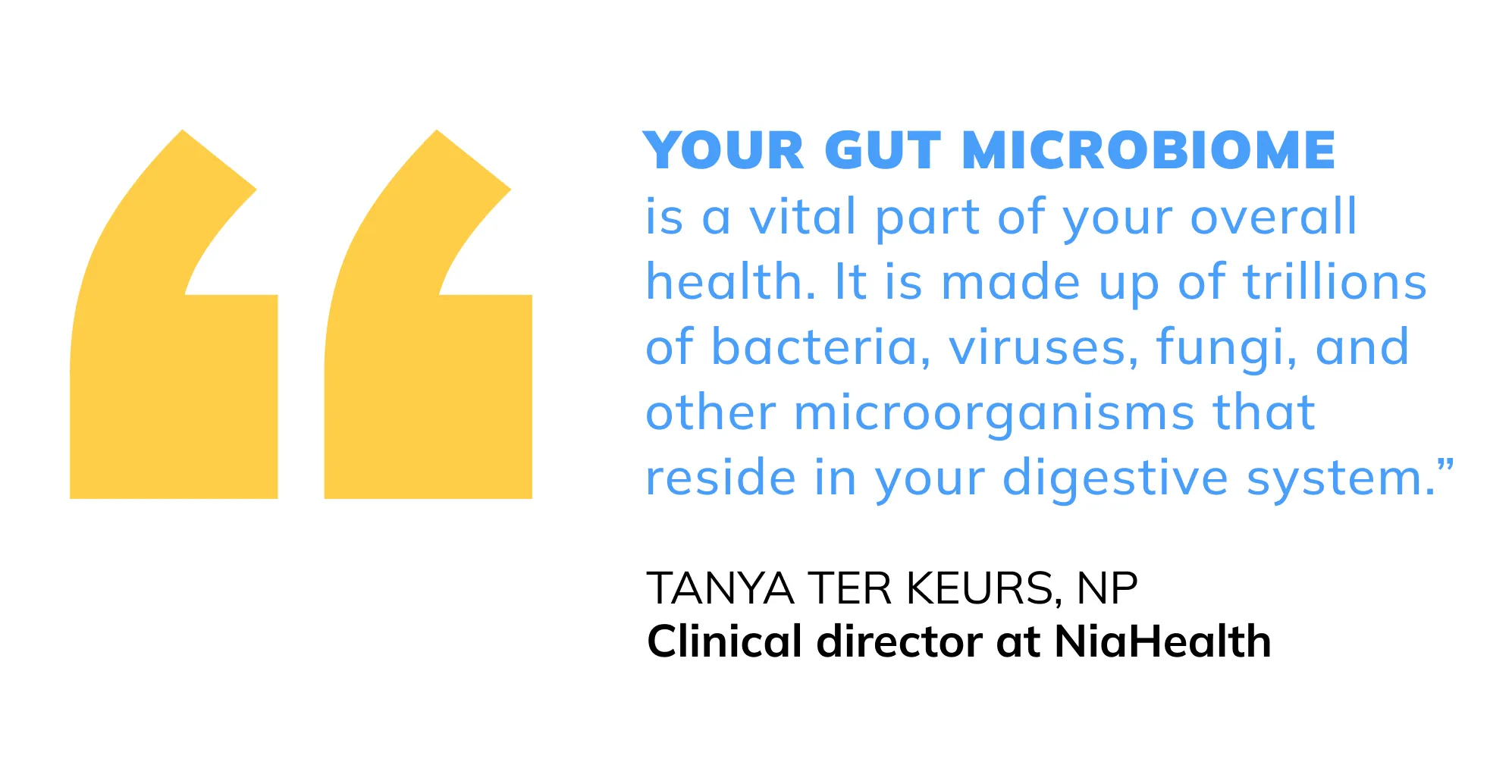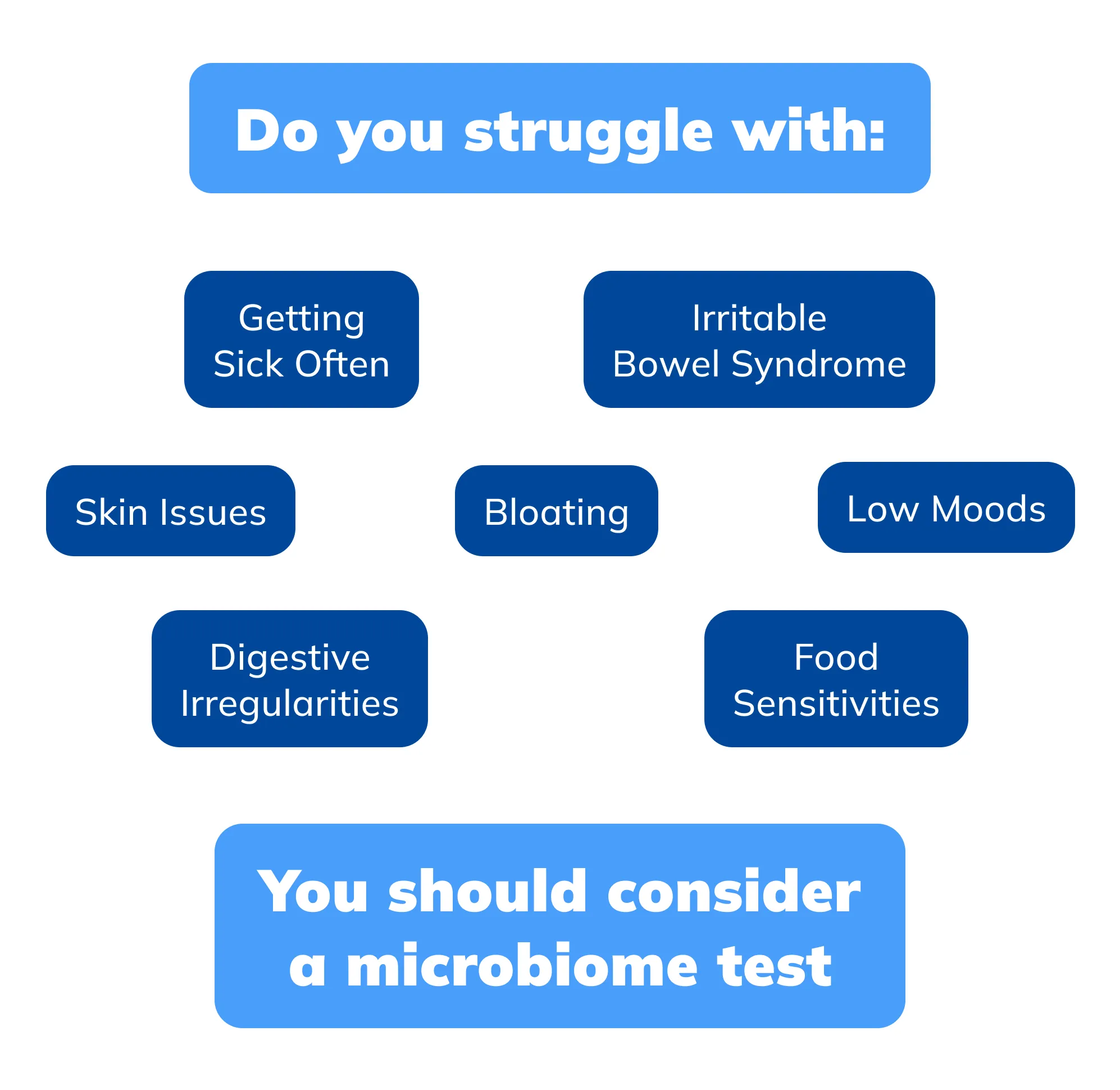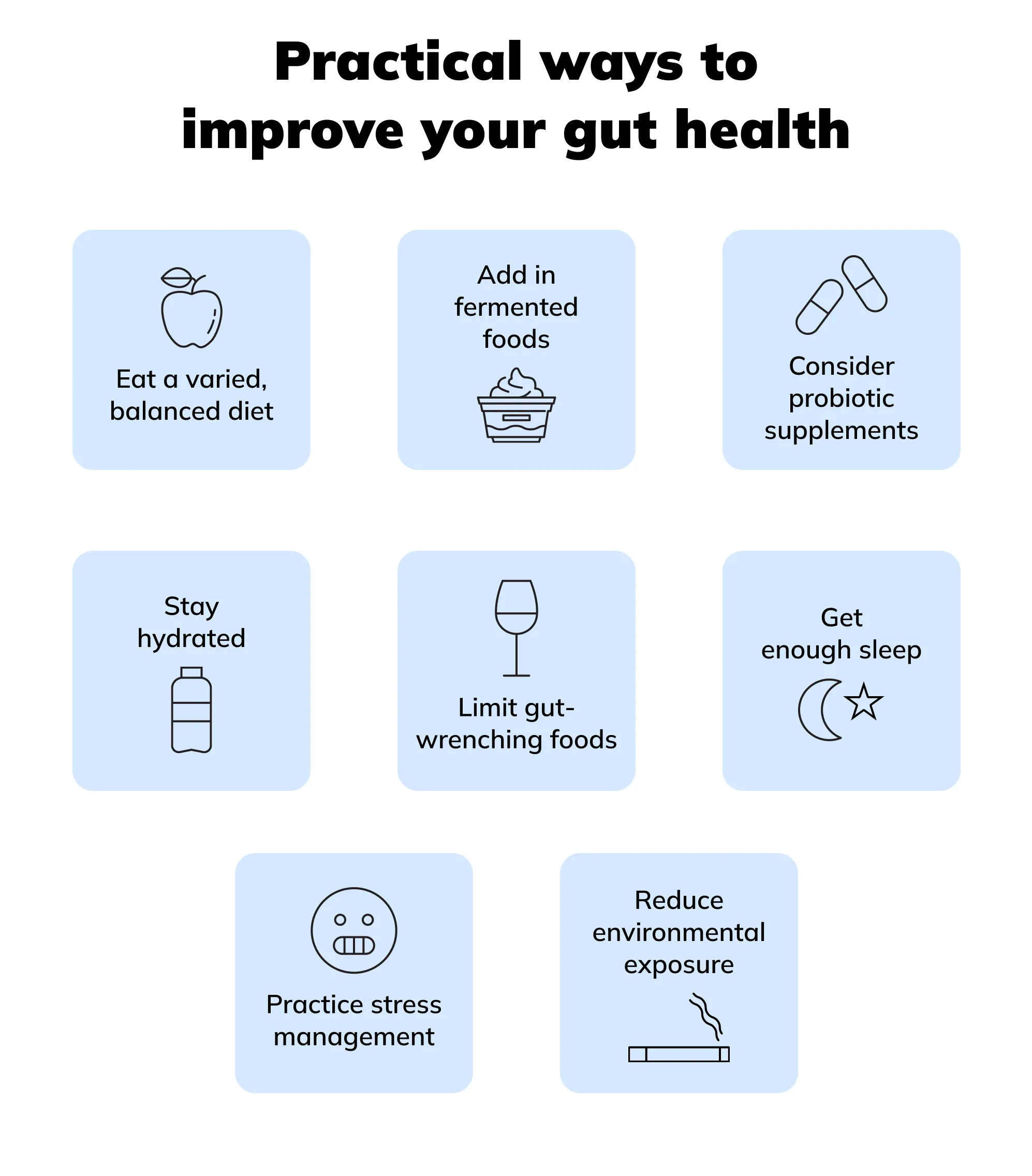Microbiome Test: What It Shows, Why It Matters, & How To Get One

Your gut microbiome is the collection of bacteria, viruses and fungi in your intestinal tract, and its balance (or lack thereof) plays a major role in healthy digestion, metabolism, immune function, and mental health. Testing your microbiome offers a number of clues about your health, and reviewing your test results with a qualified NiaHealth Clinician can offer you concrete steps to improve both how you feel and how you function.
There is evolving evidence that the gut microbiome has connections to our immunity, mood, nutritional status, and more. The online conversation surrounding what these tests can and can’t tell you, however, is confusing. Some make it sound like testing the gut microbiome is the answer to every health problem, while others think it’s less important.
Perhaps you’ve been dealing with digestive issues, fatigue, skin flare-ups, food sensitivities, or chronic inflammation, however, you want to know what’s at the root cause. A microbiome test can supply some clues, along with actionable steps to improve your health—a win-win.
We’re here to separate microbiome hype from helpful, and discuss how you can turn your microbiome results into tangible next steps.
What is a microbiome test?
Microbiome testing is typically done via stool analysis and reveals important information about the makeup of your microbiome. “Your gut microbiome is a vital part of your overall health. It is made up of trillions of bacteria, viruses, fungi, and other microorganisms that reside in your digestive system,” says Tanya ter Keurs, NP, Clinical Director at NiaHealth.

Although these “gut bugs” are located in your GI system, your digestion isn’t the only thing impacted. A healthy microbiome may also deliver benefits such as:
- Improved nutrient absorption: The GI tract is responsible for absorbing the nutrients from the food you eat, which are then used to help carry out the body’s functions. A balanced microbiome helps maintain the lining of the gut, which is crucial for proper absorption. Gut bacteria also break down food and make micronutrients available.
- Enhanced metabolic health: Dysbiosis (or gut microbiome imbalance) is associated with inflammation that promotes the development of obesity, metabolic syndrome, and type 2 diabetes.
- Immune system support: Helps regulate the immune system so that it’s strong enough to fight off pathogens that can make us sick.
- A balanced mood and improved cognition: The gut microbiome may influence brain health and the development of mental health disorders like depression. For example, serotonin in the gut could be tied to mood, and overall health.
Why should I consider a microbiome test?
It’s time to consider a microbiome test if you’re struggling with any of the following:
- Digestive irregularities like bloating, irritable bowel syndrome, or food sensitivities
- Getting sick often, or your mood is low
- Skin issues
Gut bacteria could be part of the puzzle. To know if it’s playing a role in your health challenges, you might benefit from a gut test along with clinical support to help you interpret the results and provide personalized insights and recommendations for changes you can make to your habits and routine.

What a microbiome test can reveal
A microbiome test tells you about the diversity and composition of your gut bacteria. This test identifies imbalances in bacteria, bacterial diversity, and other metrics that provide information on your gut health.
When we work with NiaHealth customers, we wrap up all this information into easily digestible (ha!) information. “Your results will give you a ‘grade,’ or score, based on key metrics, helping you understand the current state of your gut health and any areas that may need improvement,” says ter Keurs.
Remember, though, gut health testing can be part of your care plan—not the basis for it. This analysis can shed some light on what's going on inside your body, but there are limitations. For example, gut biome testing can tell you about the composition of the bacteria in your gut, but it cannot tell you why there is an imbalance or diagnose a health issue. For that reason, a gut test won’t provide all the answers to your health questions. Think of your results as more of the jumping off point to enacting healthy lifestyle habits.
How the microbiome testing process works
In order for your microbiome to be analyzed, you’ll need to get a stool sample. This will be sent off to a lab, which will test the sample for diversity and composition of the microorganisms in your gut, explains ter Keurs.
Here’s a rundown of what is typically analyzed in a gut microbiome test:
- Shannon diversity index: Measures the diversity and abundance of gut bacteria.
- Beneficial bacteria: Looks for the presence of health-promoting bacteria like Bifidobacterium, Akkermansia, and Faecalibacterium.
- Disruptive bacteria: Looks for overgrowth of bacteria (E. coli, C. difficile) that may cause digestive symptoms.
- Antibiotic resistance: Compares the balance between beneficial bacteria and antibiotic-resistant strains.
- Short-chain fatty acids (SCFAs): Beneficial bacteria produce SCFAs, which play a role in gut health, immunity, and mood.
Preparing for your microbiome test
Preparing for a microbiome test is easy: don’t do anything different! Keep following your regular diet and lifestyle. “Avoid making significant changes to your eating habits, as this can alter the microbiome results,” says ter Keurs. “The goal is for the test to reflect your typical microbiome composition.”
For the most accurate results, skip probiotics and prebiotics for at least a 1-2 months prior to the test, ter Keurs recommends. In addition, if you’ve been taking antibiotics, schedule a microbiome test at least a week after you’ve finished the medication.
Where to get the best microbiome test in Canada
If you’re looking to get a microbiome test and make the most use out of your results, follow these steps:
- Research tests: One way to access a microbiome test in Canada is for your doctor to order one. You can also order a microbiome test through a private company, which may offer some deeper analysis beyond standard care.
- Check your coverage: After exploring the options available to you, look into possible insurance coverage or eligibility under benefits like health savings accounts (HSA).
- Collect your sample: If you are taking a gut biome test at home, you will be able to collect a stool sample in the comfort of your own home and send it in for analysis.
- Discuss the results: If your healthcare provider ordered the lab testing, discuss the results with this professional. If you are testing through a private company, make sure that they also connect you with a clinician who will interpret your results, explain what they mean, and provide personalized recommendations for next steps to improve your microbiome health.
The way to make microbiome testing work for you is to connect with a company that prioritizes clinician involvement, which is the NiaHealth philosophy. At NiaHealth, a clinician will interpret your results, provide valuable, detailed insights, and suggest practical next steps you can take to better your health based on the analysis.
Understanding your microbiome test results
Received your results? That’s great! Here’s what to do next to make the most out of the gut microbiome test:
1. Discuss your results with a clinician
The companies that offer the best microbiome testing do not leave you on your own to figure out what your results mean. A clinician should review your results and discuss them with you. For example, if you have a low Shannon diversity index score, your clinician could talk to you about the lifestyle factors that are associated with a higher score, such as having a variety of plant foods in your diet and participating in regular exercise.
2. Ask additional questions
Don’t hesitate to ask for clarity on parts of the test results that you don’t understand. If the test picks up a concerning level of pathogenic bacteria like E. coli, ask if that may explain some of the persistent digestive woes you’ve been experiencing. If you have low levels of SCFAs, ask your clinician to explain what the gut needs to produce these and why that’s important for your health. Of course, a conscientious clinician understands that questions may arise later. Having the opportunity for follow-up phone calls or messages is crucial.
3. Create a plan
While it’s great to have the information on your microbiome, the key part is knowing what to do with that new knowledge. Your clinician should also discuss the practical changes you can make to your diet, lifestyle, and supplement protocol to improve your gut health. For example, there may be opportunities to add a few servings of cruciferous vegetables into your week, find the time to take a walk after dinner every day, or reduce the number of alcoholic drinks you consume weekly.
4. Retest
Discuss retesting. A follow-up gut microbiome test is usually recommended. Comparing the results of the two tests can show you how changes to your diet and lifestyle have affected your microbiome for the better.

Practical ways to improve your gut health
Following personalized recommendations based on your gut microbiome results is important, but anyone can start taking steps to better their gut health, says Kinga Balogh, a Registered Dietitian with JM Nutrition.
Here’s what she recommends:
Eat a varied, balanced diet
Focus on fruits, vegetables, legumes, nuts, seeds, and whole grains, all of which are packed with fiber. “Gut bacteria break down dietary fibers that the human body would not be able to digest otherwise, and thereby produce beneficial short-chain fatty acids to nourish the colon and reduce inflammation in the body,” says Balogh. A variety of fiber-rich foods nourish a diverse, healthy gut, suggests research.
Add in fermented foods
Yogurt, kefir, sauerkraut, kimchi, miso, tempeh, and kombucha all contain live probiotics, which help populate the gut with beneficial bacteria, Balogh says.
Consider probiotic supplements
For some people, probiotic supplements can be helpful, but these should be carefully recommended by a clinician who is knowledgeable in your health, goals, and body’s unique needs so they can recommend the right one for you and monitor its efficacy.
Stay hydrated
Sip H20 throughout the day. “Water helps digestion and supports the mucosal lining of the intestines,” says Balogh.
Limit gut-wrenching foods
Foods that are ultra-processed, those high in added sugars, and alcohol compromise the gut biome, says Balogh. “Limiting intake does not mean abstaining from consuming the occasional dessert, processed food choice, or alcoholic beverage; rather it encourages balance and moderation,” she says.
Get enough sleep
“Evidence suggests that poor or irregular sleep can reduce microbial diversity,” says Balogh. Research also points to the idea that this is a bidirectional relationship. In other words, changes in sleep can alter the gut microbiome, while the gut microbiome also helps regulate sleep.
Practice stress management
Psychological stress creates hormonal changes and increases inflammation, which affect the health of your microbiome, studies show. In turn, your microbiome can also influence how you respond to stress and affect your mood.
Cost and coverage of gut microbiome testing
Investing in a gut microbiome test can be cost-prohibitive for some people. Most people need to pay for these out of pocket.
Finding the best microbiome test in Canada will require some research to compare brands. Although prices vary among brands, look for a test that offers transparent pricing and is eligible under Health Spending Accounts (HSAs) and CRA medical expense deductions.
Compare pricing, along with what’s included in the testing package and available programs that help offset the cost, to find the microbiome test that aligns with your needs.
The bottom line
Microbiome testing is a stool test that analyzes measures like bacterial diversity and the balance of harmful and healthy bacteria. The health of your gut microbiome is an important component of your digestion, immune system, mood, and metabolic health.
For the most accurate, usable results, seek out microbiome testing through a company like NiaHealth, which provides clinically-supported testing, clear interpretation, and real-world next steps to apply your results.
Key takeaways
- Your microbiome is the collection of bacteria, viruses, and fungi that reside in your digestive tract. This microbiome plays a role in healthy digestion, metabolism, immune function, and mental health.
- Microbiome testing analyzes your gut microbiome through stool testing.
- Results provide insights into the overall health of your gut, including the diversity of your microbiome, beneficial and harmful bacteria, and the presence of compounds that shed let gut health.
- The best way to understand your results and how to apply them to improve your health is by reviewing those results with a clinician.
- Lifestyle changes can alter your gut microbiome in a positive way. Be sure to eat a healthy, balanced plant-based diet, limit ultra-processed foods, added sugars, and excessive alcohol, get regular exercise, adequate sleep, and practice stress management.
Frequently asked questions
What is a microbiome test?
A microbiome test analyzes a stool sample to measure gut bacterial diversity, healthy and harmful bacteria, and the presence of other markers that shed light on gut health.
Is it worth doing a microbiome test?
That’s something each person needs to evaluate for themselves. However, if you’re looking for personalized insights about your health or are experiencing health issues and you’re wondering if they’re connected to your gut health, microbiome testing may be a good investment.
What are signs of a healthy microbiome?
A healthy microbiome is diverse, has the right balance of beneficial versus harmful bacteria, and produces an adequate amount of short-chain fatty acids, beneficial compounds that are a sign of a healthy microbiome.
Do microbiome tests really work?
Microbiome tests can provide insight into the state of your gut health. They are valuable—or “work”—when reviewed with a clinician who can give personalized recommendations in diet or other lifestyle changes to improve your gut and overall health.
How much does a microbiome test cost?
Costs vary depending on the company you’re purchasing from. At NiaHealth, the Gut Microbiome Test, which screens for more than 50 microbial species, costs $390. To help reduce costs, look for a test that is eligible under Health Spending Accounts (HSAs) and CRA medical expense deductions.
How do I know if I have a microbiome imbalance?
Also called dysbiosis, symptoms can include bloating or changes in bowel habits. Over time, an imbalanced gut microbiome can lead to digestive issues, metabolic disorders, and a weakened immune system.
Our editorial standards & process
At NiaHealth, our mission is to make proactive health possible for all Canadians—by combining science with humanity. We believe that rigorous, evidence-informed health information should never feel out of reach. Every word we publish is intentional. We choose language that empowers rather than overwhelms, clarifies rather than complicates, and respects the lived experiences behind every health question. Learn more here.